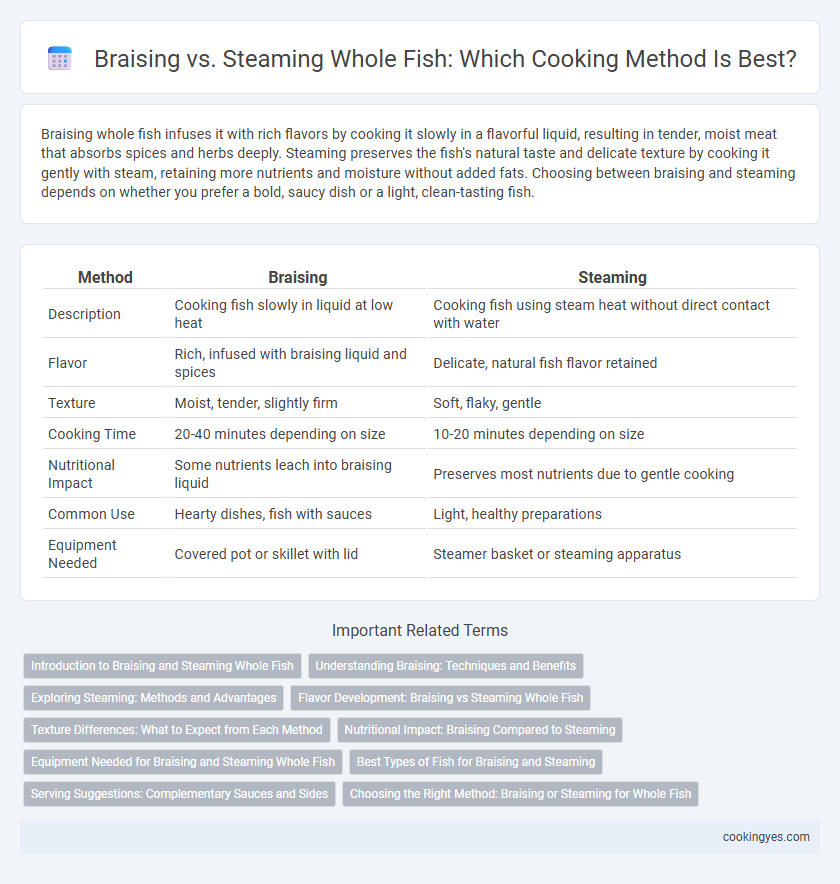Braising whole fish infuses it with rich flavors by cooking it slowly in a flavorful liquid, resulting in tender, moist meat that absorbs spices and herbs deeply. Steaming preserves the fish's natural taste and delicate texture by cooking it gently with steam, retaining more nutrients and moisture without added fats. Choosing between braising and steaming depends on whether you prefer a bold, saucy dish or a light, clean-tasting fish.
Table of Comparison
| Method | Braising | Steaming |
|---|---|---|
| Description | Cooking fish slowly in liquid at low heat | Cooking fish using steam heat without direct contact with water |
| Flavor | Rich, infused with braising liquid and spices | Delicate, natural fish flavor retained |
| Texture | Moist, tender, slightly firm | Soft, flaky, gentle |
| Cooking Time | 20-40 minutes depending on size | 10-20 minutes depending on size |
| Nutritional Impact | Some nutrients leach into braising liquid | Preserves most nutrients due to gentle cooking |
| Common Use | Hearty dishes, fish with sauces | Light, healthy preparations |
| Equipment Needed | Covered pot or skillet with lid | Steamer basket or steaming apparatus |
Introduction to Braising and Steaming Whole Fish
Braising whole fish involves cooking it slowly in a flavorful liquid, such as broth or wine, which infuses the fish with rich aromas and keeps it moist. Steaming whole fish uses hot steam to cook gently, preserving its delicate texture and natural flavors without added fats. Both methods enhance the fish's freshness while catering to different taste preferences and culinary styles.
Understanding Braising: Techniques and Benefits
Braising whole fish involves cooking in a small amount of flavorful liquid at low heat, allowing the fish to absorb rich flavors while maintaining moisture. This technique enhances the texture by gently breaking down connective tissues, resulting in tender, succulent fish. Braising also infuses the fish with aromatic ingredients like herbs, spices, and vegetables, creating a complex and savory dish.
Exploring Steaming: Methods and Advantages
Steaming whole fish preserves its delicate texture and moisture by cooking it evenly with gentle heat, which helps retain essential nutrients and natural flavors. Common steaming methods include using bamboo baskets, metal steamers, or electric steamers, each allowing precise control over cooking time and temperature. This technique minimizes the need for added fats, making it a healthy, low-calorie option preferred in various global cuisines.
Flavor Development: Braising vs Steaming Whole Fish
Braising whole fish enhances flavor development by allowing the fish to absorb rich, savory liquids and spices through slow cooking, resulting in a deeply infused taste and tender texture. Steaming preserves the natural, delicate flavors of the fish, emphasizing freshness and subtlety while maintaining moisture without added fats or strong seasonings. Choosing braising intensifies complexity, whereas steaming highlights purity and natural essence in whole fish preparation.
Texture Differences: What to Expect from Each Method
Braising whole fish results in a tender, flavorful texture as the slow cooking process allows the flesh to absorb rich braising liquid, often yielding a moist and flaky consistency with a slightly firmer exterior. Steaming preserves the fish's delicate, natural texture by gently cooking it with moist heat, which keeps the flesh soft, moist, and subtly flaky without added fat or browning. Each method distinctly influences the mouthfeel, with braising offering more robust, infused flavors and steaming providing a purer, lighter fish taste.
Nutritional Impact: Braising Compared to Steaming
Braising whole fish involves cooking in a small amount of liquid at lower temperatures, which can help retain moisture and infuse flavors but may cause some loss of heat-sensitive nutrients like vitamin C. Steaming preserves more nutrients such as omega-3 fatty acids, B vitamins, and antioxidants due to the gentle, indirect heat and lack of added fats. Both methods maintain high protein quality, but steaming is generally superior for preserving the full nutritional profile of whole fish.
Equipment Needed for Braising and Steaming Whole Fish
Braising whole fish requires a heavy, oven-safe pot or deep skillet with a tight-fitting lid to trap moisture and distribute heat evenly, while steaming necessitates a sturdy steamer basket or rack that fits inside a pot with a lid to allow steam circulation. For braising, a heatproof pan resistant to high temperatures is essential, often complemented by tongs or a spatula for careful handling. Steaming equipment also includes a lid that seals properly to maintain consistent steam pressure and prevent heat loss throughout the cooking process.
Best Types of Fish for Braising and Steaming
Braising is ideal for firm, fatty fish like salmon, cod, and halibut as the slow cooking method enhances their rich flavors and maintains moisture. Steaming suits delicate, flaky fish such as sole, flounder, and sea bass, preserving their tender texture and subtle taste. Both methods benefit from choosing fresh, whole fish with firm flesh to achieve optimal results.
Serving Suggestions: Complementary Sauces and Sides
Braising whole fish enhances rich, savory flavors and pairs exceptionally well with robust sauces like tomato-based ragu or soy-ginger glaze, complemented by sides such as root vegetable mash or sauteed greens. Steaming preserves the delicate texture and subtle taste, making light citrus-soy or ginger-scallion sauces ideal accompaniments, alongside steamed jasmine rice and stir-fried bok choy. Both methods offer versatile serving options that highlight the fish's natural qualities while enhancing the overall dining experience.
Choosing the Right Method: Braising or Steaming for Whole Fish
Choosing the right cooking method for whole fish depends on desired flavor and texture; braising infuses rich, savory flavors through slow cooking in liquid, resulting in tender, moist fish with enhanced depth. Steaming preserves the fish's natural taste and nutrients while maintaining a delicate, flaky texture, ideal for lighter, health-conscious dishes. Consider the fish species and recipe goals to optimize moisture retention and flavor integration, ensuring perfect culinary results.
Braising vs Steaming for whole fish Infographic

 cookingyes.com
cookingyes.com